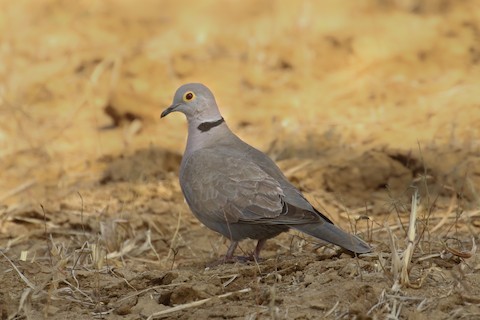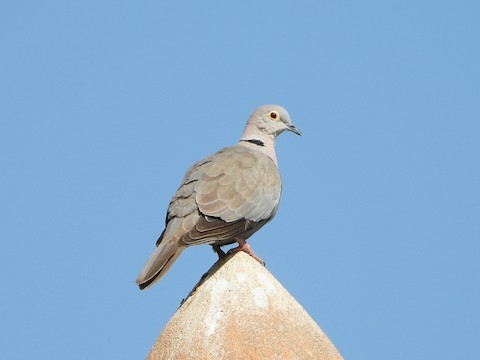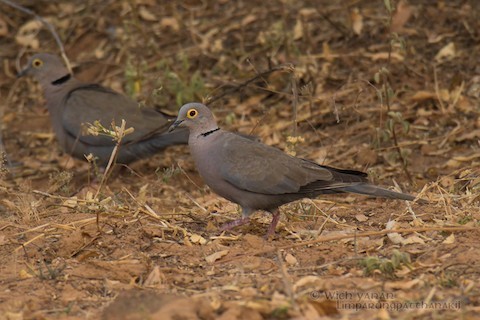Birdfinding.info ⇒ The Burmese endemic form of Eurasian Collared-Dove—perhaps best regarded as a separate species—is locally common in its limited range. It is especially common in the Mandalay Region, including Mandalay City. One often-visited site where it is readily observed is Bagan.
“Burmese Collared-Dove”
Streptopelia decaocto xanthocycla
Endemic to the Irrawaddy Valley of central and southern Myanmar. Many references indicate that it also occurs in southern and eastern China, but there appears to be no publicly available evidence to confirm any records outside of Myanmar.
Identification
A brown turtle-dove with a black half-collar and a wide vivid-yellow eyering.

“Burmese Collared-Dove”, S. d. xanthocycla, showing mostly grayish-brown tones in the plumage. (Bagan, Mandalay, Myanmar; February 10, 2020.) © Frank Thierfelder
Most of the plumage is usually a somewhat uniform shade of medium- to pale-brown, though the head and neck tend to appear paler than the rest. The overall tone of the plumage varies from reddish to grayish to dark-brown, often with a rosy or vinaceous blush on the head, neck, and breast.
Generally resembles its much more widespread close relative, the “Eurasian Collared-Dove” (decaocto), but darker and easily distinguished by its prominent eyering.

“Burmese Collared-Dove”, S. d. xanthocycla, appearing mostly pale-gray or sandy-brown when brightly lit—note also that the eyering is less conspicuous in bright lighting. (Bagan, Mandalay, Myanmar; December 23, 2019.) © Barry Reed
The black half-collar is accentuated by grayish borders above and below.
The eyes are dark-red, but often appear dark-brown or black when not fully illuminated.
The legs are usually pale-pink, but can also appear pale-gray.

“Burmese Collared-Dove”, S. d. xanthocycla, appearing mostly dark-brown. (Bagan, Mandalay, Myanmar; March 23, 2018.) © Wich’yanan Limparungpatthanakij

“Burmese Collared-Dove”, S. d. xanthocycla, appearing warm coppery-brown with a rosy flush. (Bagan, Mandalay, Myanmar; January 2, 2015.) © Carlos Bocos
Voice. Typical call is a two-note phrase, CRP-cuuu, with the first note emphatic and clipped, and the second note falling and drawn-out: Also gives three- and four-syllable variants:
Notes
Monotypic form, one of two potentially distinct forms of the Eurasian Collared-Dove (decaocto). Based on apparent differences in bare parts, plumage coloration, and voice, it seems likely that “Burmese” will eventually be recognized as a separate species.
References
BirdLife International. 2019. Streptopelia decaocto. The IUCN Red List of Threatened Species 2019: e.T22727811A154457750. https://dx.doi.org/10.2305/IUCN.UK.2019-3.RLTS.T22727811A154457750.en. (Accessed March 2, 2022.)
Brazil, M. 2009. Birds of East Asia. Princeton University Press, Princeton, N.J.
eBird. 2022. eBird: An online database of bird distribution and abundance. Cornell Lab of Ornithology, Ithaca, N.Y. http://www.ebird.org. (Accessed March 2, 2022.)
Gibbs, D., E. Barnes, and J. Cox. 2001. Pigeons and Doves: A Guide to the Pigeons and Doves of the World. Yale University Press, New Haven, Connecticut.
Xeno-Canto. 2022. Eurasian Collared Dove – Streptopelia decaocto. https://xeno-canto.org/species/Streptopelia-decaocto. (Accessed March 2, 2022.)
